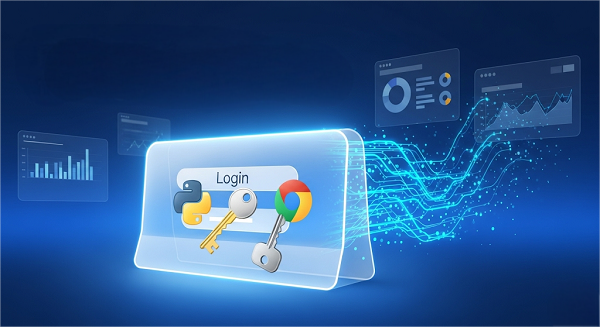Complete Guide to Proxy Servers for PS4 & PS5: Setup, Use Cases & Pro Tips
Complete PS4/PS5 proxy guide: setup steps, when proxies help, troubleshooting, and advanced tips for low-latency gaming.
Nov 10, 2025
Learn free, step-by-step web scraping for login-protected sites with Python, tools, and tips for all levels.
Ever hit a login wall when collecting data? Valuable sources like private forums, member-only dashboards, or e-commerce analytics are locked behind authentication. While this adds security, it’s not an end to scraping. Whether you’re a beginner gathering insights or a professional automating data collection, this guide offers free, practical methods to scrape login-required websites legally, ethically, and effectively. We’ll cover three scenarios—from simple form logins to bypassing JavaScript and anti-bot defenses.

Gather Member-Only Insights: Monitor private forums, review subscriber-only content, track internal dashboards.
Competitive Intelligence: Access product pricing or stock levels hidden behind accounts.
Automation & Reporting: Pull your own account data automatically for analytics and reporting.
Scraping login-required sites involves three core challenges:
| Authentication | Anti-Bot Defenses | Legal & Ethical Checks |
| CSRF or hidden tokens | CAPTCHAs & JavaScript challenges | Website Terms of Service (ToS) |
| Persistent session cookies | WAF/Cloudflare protections | GDPR/CCPA data-privacy compliance |
| JavaScript-driven login flows | Rate limiting & IP bans | Responsible request pacing |
What This Means:
Authentication: Handle mechanisms like CSRF tokens, session cookies, or JavaScript-based logins.
Anti-Bot Defenses: Overcome CAPTCHAs, Web Application Firewalls (e.g., Cloudflare), or rate limits using tools like headless browsers or proxies.
Legal & Ethical Checks: Comply with ToS, privacy laws (e.g., GDPR/CCPA), and pace requests to avoid server strain.
Before scraping, follow this checklist:
Confirm scraping isn’t prohibited. Check the website’s Terms of Service to avoid bans or legal trouble.
Protect your real credentials and data by testing with a separate, disposable account.
Only collect data you’re authorized to use, ensuring compliance with regulations like GDPR or CCPA.
Insert delays (e.g., time.sleep(2) in Python) to mimic human behavior and prevent server strain.
No expensive software needed—here’s what works:
User-friendly platforms with graphical interfaces let beginners scrape without coding. Look for “login flow” support:
1. Record Login Flow: Click “Log In,” enter credentials.
2. Point & Click Extraction: Select elements to scrape.
3. Export Results: Download CSV or JSON.
| Tool | Install | Purpose |
| requests | pip install requests | Send HTTP GET/POST and manage sessions |
| BeautifulSoup4 | pip install beautifulsoup4 | Parse HTML to extract tokens & data |
| Selenium | pip install selenium | Automate browsers for JS-heavy logins |
Note: These open-source tools suit all skill levels.
This is the simplest case—submit your username and password directly to the login URL using Python’s requests library. After logging in, the session persists for scraping protected pages.
Use When: Static HTML form, no CSRF or JavaScript.
Code Example:
python
import requests
session = requests.Session()
login_url = "https://example.com/login"
payload = {"username": "you", "password": "pass"}
resp = session.post(login_url, data=payload)
if "Dashboard" in resp.text:
print("✅ Login successful")
Editor’s Tip: Replace "Dashboard" with a unique text or element from your target page.
Many sites use CSRF tokens to prevent unauthorized form submissions. You’ll need to fetch the login page first, extract the token, and include it in your login request.
Use when: Login form includes hidden csrf_token or authenticity tokens.
Code Example:
python
import requests
from bs4 import BeautifulSoup
session = requests.Session()
# 1. GET login page
resp = session.get("https://example.com/login")
soup = BeautifulSoup(resp.text, "html.parser")
# 2. Extract token
token = soup.select_one('input[name="csrf_token"]')['value']
# 3. POST credentials + token
payload = {"username": "you", "password": "pass", "csrf_token": token}
login = session.post("https://example.com/login", data=payload)
For complex sites, use Selenium to automate a browser and handle JavaScript. After logging in, transfer the cookies to a requests session for faster scraping. Add techniques to avoid rate limits or IP bans.
Use when: Sites with JS-rendered forms or anti-bot protections.
Code Example:
python
from selenium import webdriver
from selenium.webdriver.chrome.options import Options
options = Options(); options.headless = True
driver = webdriver.Chrome(options=options)
driver.get("https://example.com/login")
driver.find_element("name","username").send_keys("you")
driver.find_element("name","password").send_keys("pass")
driver.find_element("css selector","button.submit").click()
python
import requests
session = requests.Session()
for ck in driver.get_cookies():
session.cookies.set(ck['name'], ck['value'])
# Use session for subsequent scraping
resp = session.get("https://example.com/data")
Random Delays:
python
import time, random
time.sleep(random.uniform(1, 3))
Free Proxies: Use lists from sites like http://free-proxy-list.net:
python
proxies = {"http": "http://10.10.1.10:3128"}
session.get("https://example.com/data", proxies=proxies)
Note: Free proxies can be unreliable. For serious scraping, consider paid proxy services for better speed and uptime, like GoProxy.
Tips:
| Issue | Cause | Quick Fix |
| 401 Unauthorized | Incorrect payload or headers | Verify form field names; add headers like Referer |
| Missing Data | Logged out or expired session | Check session.cookies; re-authenticate if needed |
| Captcha Appears | Bot detection triggered | Slow down, randomize delays, or handle manually |
| Intermittent Failures | Rate limiting | Implement retries with exponential backoff |
Error Handling: Wrap requests in try/except and retry failed attempts after a pause.
Test Small: Start with a few pages to validate your workflow before scaling up.
Scraping login-protected websites is a skill worth mastering. Beginners can use no-code tools, while coders can leverage Python to handle everything from simple forms to anti-bot defenses. Start small, test carefully, and always respect the sites you scrape.
Need high quality proxy servie for web scraping? Rotating redsidential proxies 87% Off now! Also, unlimited traffic plans for your scale needs. Sign up today to get your free trial.
< Previous
Next >
 Cancel anytime
Cancel anytime No credit card required
No credit card required